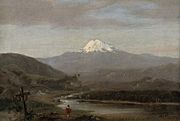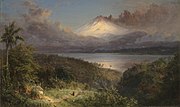
Frederic Edwin Church was an American landscape painter born in Hartford, Connecticut. He was a central figure in the Hudson River School of American landscape painters, best known for painting large landscapes, often depicting mountains, waterfalls, and sunsets. Church's paintings put an emphasis on realistic detail, dramatic light, and panoramic views. He debuted some of his major works in single-painting exhibitions to a paying and often enthralled audience in New York City. In his prime, he was one of the most famous painters in the United States.

The Hudson River School was a mid-19th-century American art movement embodied by a group of landscape painters whose aesthetic vision was influenced by Romanticism. Early on, the paintings typically depicted the Hudson River Valley and the surrounding area, including the Catskill, Adirondack, and White Mountains.

Cayambe or Volcán Cayambe is a volcano in Ecuador, in the Cordillera Central, a range of the Ecuadorian Andes. It is located in Pichincha Province, some 70 km (43 mi) northeast of Quito. It is the third-highest mountain in Ecuador, at an elevation of 5,790 m (18,996 ft) above sea level.

Jervis McEntee was an American painter of the Hudson River School. He is a lesser-known figure of the 19th-century American art world, but was a close friend and traveling companion of several of the important Hudson River School artists. Aside from his paintings, McEntee's unpublished journals, written from 1872 to 1890, are an enduring legacy, documenting the life of a New York painter during and after the Gilded Age.

Martin Johnson Heade was an American painter known for his salt marsh landscapes, seascapes, and depictions of tropical birds, as well as lotus blossoms and other still lifes. His painting style and subject matter, while derived from the romanticism of the time, are regarded by art historians as a significant departure from those of his peers.

Fortunato Arriola (1827–1872) was a Mexican portraitist and landscape painter, of Spanish descent. He is considered one of the pioneer artists of California, and his work was popular in San Francisco, where he came to live in 1857. Arriola primarily painted portraits, sunsets, and luminous tropical landscapes.

Luminism is a style of American landscape painting of the 1850s to 1870s, characterized by effects of light in a landscape, through the use of aerial perspective and the concealing of visible brushstrokes. Luminist landscapes emphasize tranquility, often depicting calm, reflective water and a soft, hazy sky. Artists who were most central to the development of the luminist style include Fitz Henry Lane, Martin Johnson Heade, Sanford Gifford, and John F. Kensett. Painters with a less clear affiliation include Frederic Edwin Church, Jasper Cropsey, Albert Bierstadt, Worthington Whittredge, Raymond Dabb Yelland, Alfred Thompson Bricher, James Augustus Suydam, and David Johnson. Some precursor artists are George Harvey and Robert Salmon. Joseph Rusling Meeker also worked in the style.

Olana State Historic Site is a historic house museum and landscape in Greenport, New York, near the city of Hudson. The estate was home to Frederic Edwin Church (1826–1900), one of the major figures in the Hudson River School of landscape painting. The centerpiece of Olana is an eclectic villa which overlooks parkland and a working farm designed by the artist. The residence has a wide view of the Hudson River Valley, the Catskill Mountains and the Taconic Range. Church and his wife Isabel (1836–1899) named their estate after a fortress-treasure house in ancient Greater Persia, which also overlooked a river valley.

The Heart of the Andes is a large oil-on-canvas landscape painting by the American artist Frederic Edwin Church (1826–1900). It depicts an idealized landscape in the South American Andes, where Church traveled on two occasions. Measuring more than five feet high and almost ten feet wide, its New York City exhibition in 1859 was a sensation, establishing Church as the foremost landscape painter in the United States.

El Rio de Luz is an 1877 oil painting by American landscape artist Frederic Edwin Church. It is his last large-scale painting of South America, following pieces such as The Andes of Ecuador (1855) and The Heart of the Andes (1859). Like them, the painting is a composite of the many sketches and drawings Church made while traveling in South America twenty years earlier.

Aurora Borealis is an 1865 painting by the American artist Frederic Edwin Church of the aurora borealis and the Arctic expedition of Isaac Israel Hayes. The painting measures 142.3 by 212.2 centimetres and is now owned by the Smithsonian American Art Museum.

The Icebergs is an 1861 oil painting by the American landscape artist Frederic Edwin Church. It was inspired by his 1859 voyage to the North Atlantic around Newfoundland and Labrador. Considered one of Church's "Great Pictures"—measuring 1.64 by 2.85 metres —the painting depicts one or more icebergs in the afternoon light of the Arctic. It was first displayed in New York City in 1861, where visitors paid 25 cents' admittance to the one-painting show. Similar exhibitions in Boston and London followed. The unconventional landscape of ice, water, and sky generally drew praise, but the American Civil War, which began the same year, lessened critical and popular interest in New York City's cultural events.

Niagara Falls, from the American Side is a painting by the American artist Frederic Edwin Church (1826–1900). Completed in 1867, it is based on preliminary sketches made by the artist at Niagara Falls and on a sepia photograph. It is Church's largest painting. The painting is now in the collection of the Scottish National Gallery. Church was a leading member of the Hudson River School of painters.

Niagara is an oil painting produced in 1857 by the American artist Frederic Edwin Church. Niagara was his most important work at the time, and confirmed his reputation as the premier American landscape painter of the time. In his history of Niagara Falls, Pierre Berton writes, "Of the hundreds of paintings made of Niagara, before Church and after him, this is by common consent the greatest."

The Andes of Ecuador is an 1855 oil painting by Frederic Edwin Church, the premier American landscape painter of the time. It is the most significant result of his 1853 trip to South America, where he would travel again in 1857. It is Church's first major painting, his largest work at the time, and "an early masterpiece of Luminism", according to the Reynolda House Museum of American Art in Winston-Salem, North Carolina, which holds the painting.

Twilight in the Wilderness is an 1860 oil painting by American painter Frederic Edwin Church. The woodlands of the northeastern United States are shown against a setting sun that intensely colors the dramatic altocumulus clouds. Church scholar John K. Howat describes the painting as "one of his finest ever" and as "the single most impressive example of Church's depictions of unsullied North American woodlands and their most famous representation in nineteenth-century painting".

Louis Rémy Mignot was an American painter of Catholic descent. Associated with the Hudson River School of landscape artists, his southern US heritage and the influence of his time spent in Europe gave him a distinct style within that group, in painting vegetation and atmospheric effects.

Mountain Landscape, previously known as Sunset—West Rock, New Haven, is an 1849 landscape painting by American artist Frederic Edwin Church of the Hudson River School, completed during his early period. The work depicts a mountain landscape with a lake and a small farm in the Northeastern United States based on Church's travels through the state of Vermont. The painting was originally part of the Nickerson art collection but was later donated to Valparaiso University as part of the Sloan bequest in 1953 and exhibited at the Brauer Museum of Art. In 2023, the university proposed selling the painting as an asset to fund dormitory renovations, leading to a contentious debate about the ethics of deaccessioning artwork.

























